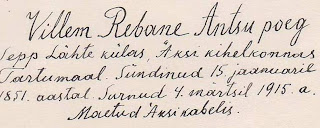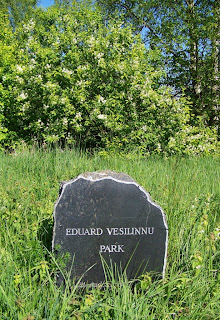About two months ago, I began to notice each afternoon after school and on Saturday mornings a cluster of tiny sailboats in the bay. I went down to the Pirita marina to see what was going on. There I found children, perhaps nine years and older, helping each other to push tiny sailboats down a ramp into the channel of the Pirita Olympic Marina. One child, one boat—sometimes twenty or more children and boats at a time. At other times I watched a different class of older kids having their group lessons.


The smallest boats are no larger than generous bathtubs, and their masts are so short that the young sailors get lots of experience in trying to catch wind in their sails as they tack in zig-zag fashion between the piers and into the bay. Their instructors, in motorized rafts, help them only when they are in serious trouble. The sailors call back and forth, excited and teasing, exchanging advice about how to go faster. They test each other with short, informal racing, and they sail so close to each other that I wonder how they do not get tangled up. Learning how to sail looks like a social experience for them. They are already behaving like their own yacht club.

In a sense, we could say that Estonians have sailing in their blood. With such a long coastline and so many islands, people living in this region have sailed for thousands of years. (You can check out some history at the Maritime Museum in Old Town.)
And Pirita is famous for sailing. The Olympic Centre is described on the web as “the most famous sailing centre in Eastern Europe.” Imagine a wide sandy beach, a protective river mouth, and strong, even tricky winds.
As a young man during Estonia’s first period of independence, Aarne’s father, Paul, built his own boat and enjoyed sailing it out of Pirita harbor into Tallinn Bay. In those days of the 1920s and 1930s, Paul would only need to be thinking about his skills, the weather, and his boat. Family lore says that the Vesilind name, meaning “waterbird,” was earned when long-ago ancestors smuggled goods along the coast in boats so fast that they outran any pursuers.
But later, during the twentieth century Soviet occupation of Estonia, a guard was positioned twenty-four hours a day at the mouth of the Pirita River. Only sailors with special permission were allowed to exit the river and go into the bay. If a boat went out, even with permission, and did not return on time, the incident was reported. (If anyone reading this knows how Soviet sailing permissions were granted and how difficult it was to get such permission, I’d be glad to learn about that.)
Some Estonians from coastal areas and the islands had earlier escaped to Sweden and Finland in their family boats and in fishing boats, and so the Soviets tried hard to lock up the coastline. After the fisheries were collectivized, all fishing boats became state property. This meant that trying to sail out of Estonia on a fishing boat was not only punishable as escape but also as theft of state property. [Glenn Eric Kranking. (2004). Agitating the Minority: Propaganda Aimed at the Ethnic Swedes in Soviet-Occupied Estonia, 1940-41. Master’s Thesis, University of Tartu Department of History. (http://www.utlib.ee/ekollekt/diss/mag/2004/b16719360/Kranking.pdf)]
One man told us that, as a child, he was warned never to stand on the big rocks in the water along the beach, because guards would confront him. Another woman described how workers in Pirita every night raked the beach to draw a line in the sand beyond which people were not allowed to step. The guards must have thought highly of Estonians’ swimming abilities!
At the same time, Soviet leaders valued sports as a way to promote health in workers, and, as occupation continued, they encouraged development of facilities for competitive sports and general recreation. For example, the Kalev Yacht Club organized in 1948 as the Tallinn Kalev Yacht Club. (Did the Soviets realize that “Kalev” is the name of the legendary Estonian national hero?) During occupation, Pirita hosted major yachting events, such as the Baltic Regattas. Yachtsmen also came from across the U.S.S.R. to Pirita to train for Olympic regattas.
In 1980, when the U.S.S.R. hosted the Summer Olympics, Moscow was the main venue, but the sailing competition was held in Pirita. The Soviet government built a marina in Pirita, the same marina where I watch the young sailors. The marina sits at the mouth of the Pirita River, where the river enters the Baltic Sea. This summer tour buses arrive almost daily to photograph the 1980 Olympic logo, which still stands as a tall red marker at the marina exit, along with the large bowl that held the Olympic flame. The next photo shows a 1980 Olympic sailing button and an Olympic promotional booklet—Pirita: Venue of the 1980 Olympic Regatta by Jaan Tamm.
The next photo shows a 1980 Olympic sailing button and an Olympic promotional booklet—Pirita: Venue of the 1980 Olympic Regatta by Jaan Tamm.

In this booklet Tamm hints at the international aspirations of Estonian sailors. He wrote, “Our yachtsmen have friendly relations with the yachtsmen of other countries. Especially sound are the ties that bind Tallinn’s yachtsmen with their colleagues in Poland and the German Democratic Republic who have taken part in all international Baltic Regattas. . . . In 1961 Britton Chance from the USA, the Olympic winner at Helsinki and world champion, sailed in the Bay of Tallinn, being the first yachtsman from abroad to win the Baltic Regatta.”
Then, before the 1980 Olympics, the U.S.S.R. invaded Afghanistan. Although the U.S. and other western countries responded with a boycott of Olympic events, the Soviets held the games and regattas anyway. While Soviet leaders in Moscow may have seen the 1980 Olympics as an indication of international approval and leaders in the west saw the boycott as a means of disapproval, the Estonian sailors in 1980 must have yearned for international competition, to test themselves against the best.
A leader and trainer for that 1980 Olympic sailing program is still at Kalev Yacht Club. In a notice about a 2006 race, he was described this way: “Mr. Rein Ottoson, Chief Trainer of the Estonian Olympic Team, is a worldwide known character and a skillful organizer. The basic planning and running of the coming Event lays [sic] in his steady hands and his Eagle sharp eyes.”
So, when I saw on the internet that Kalev Yacht Club is hosting a regatta in July 2008, in one way this seemed no surprise. Then again, as I read more details, this rather dry, formal announcement made my heart beat faster. Some races will be as long as 90 nautical miles, out in the Baltic Sea, out of sight of shore. And the announcement of rules includes this: “Estonian yachts shall be registered in Estonian Yachting Union and entered into the Estonian Register of Ships or Small Craft – all registration letters and certificates shall be presented.” Furthermore, helmsmen [and helmswomen?] must follow International Regulations for Preventing Collisions at Sea. (http://prizrak331.ru/race/2008/muhu/poloj.pdf) It may sound like business as usual, but behind all this protocol is the understanding that sailors clearly have returned to supervising their own sport.
It turns out that sailors are not alone in appreciating the tricky strong winds at Pirita. Did you know that websites for kiteboarders now report Estonian conditions? Having found Pirita on a map for kiteboarders, my son Drew arrived two weeks ago with his equipment. Like sailors, kiteboarders use the wind as well as their bodies and boards to change direction and speed. Also like sailors, kiteboarders control their kite (sail) with ropes and board (rudder.) A sailor of a small boat holds onto the line that pulls the sail in or lets it out, while the kiteboarder wears a harness that is hooked to the kite lines. From these photos you can imagine how strong the wind was when Drew tested Pirita (or was Pirita testing Drew??) As Drew was unpacking his sail, he realized that he had brought the Estonian colors—just a coincidence??



As Aarne, Drew, and I were walking home from the Pirita beach, we noticed that one of the young boys in the sailing class had lost his line. Evidently he had forgot to put a knot in the end of the line, or perhaps his knot had come undone. The strong wind was blowing his little boat toward the bridge, and his mast was not going to clear the bridge surface. While he struggled to hold the boom with his hands, the wind filled his sail and pushed the boat up against the marina wall on which we were walking. Although we did not want to embarrass this young sailor by leaning over the railing to hold his mast for him, in the end that became the only solution until his instructor could come to tow him back to the launch ramp.

Later the three of us talked about how impressive a lesson this must have been for the boy. From now on his knots will no doubt be excellent. So when I see the tiny white sails all clustered together like waterbirds out in the bay, I imagine that the boy with his improved knots is one of them. And I wonder if these adventurous children understand the history that launches them into their sailing.
--Libby















































